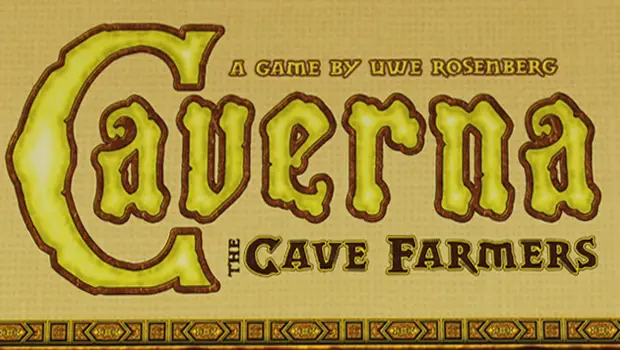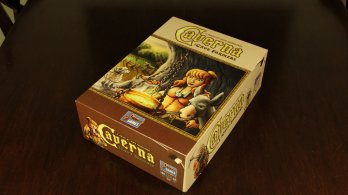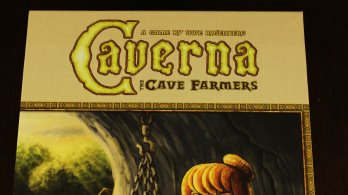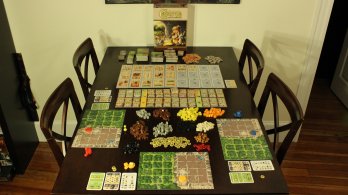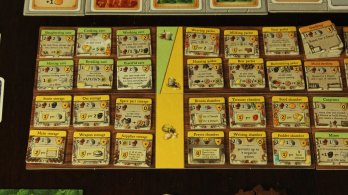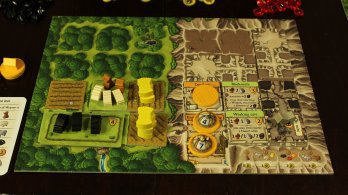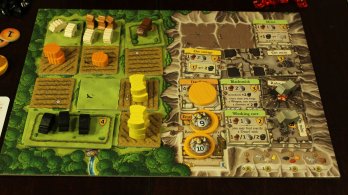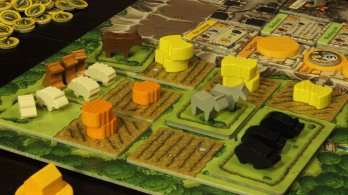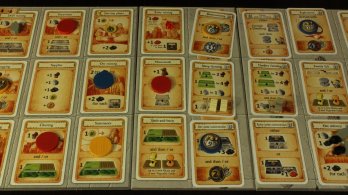We are going to play a game. I am going to give you a genre of board game, and you are going to give me the first game that comes to mind. Ready?
Eurogame with worker placement involving 17th century farming.
If you said Agricola, give yourself a high five. Notice what I did there? If I just said Eurogame, I was worried some people might say Catan (gross). If I said worker placement, I was concerned that some people would say Caylus (kill me now). But the 17th century farming… yeah that can only be the one and only Agricola. As we all know, Agricola has become the quintessential Eurogame. It proves that good mechanics can get people to play a game about farming and that a game can not have too many wooden cubes. Now, if you don’t know what Agricola is, don’t worry, now that Mr. Rosenberg has gifted us mere mortals with Caverna, there is no reason to waste any more time dealing with that previously mentioned game.
In Caverna, each player is playing as a dwarven family trying to make it by. Your family will start with just two dwarfs, but as they expand into the mountain and clear the surrounding forests, it will grow. Mining for ore and precious rubies or working the plow and farming grains and crops, you will need to make sure that your family has enough food to prevent shameful begging. Of course dwarves are prone to glory and honor, so some adventuring is always a good choice.
[singlepic id=18302]
Overview:
Caverna is a worker placement game where players try to build up the best farm/cave system. Each player starts the game with two disks in their color, representing their two dwarfs, and a mostly empty player board. The player board is split in half, one side being the forest and the other being the cave. As the game progresses, players will be building farms and pastures on cleared forest land, and will be building rooms and mines in the cleared out cave spaces. In the center of the play area are the action spaces the hold the different actions that players can take on their turn. In turn order players will place one worker on a space and take that action.
The basic resources of the game are wood and stone. These are used to build dwelling spaces for more dwarves, and for upgrading open grassland to pastures, among other things. In the mines, players will have access to ore and rubies. Ore is mainly used for equipping dwarves for adventure. Rubies act as a wild resource, providing one of any other resource or animal. On the farming side, there are grains and vegetables. Each can be used in various ways to produce food for consumption or end game points. Last but not least, there are a plethora of animals: dogs, sheep, wild boars, donkeys and cows. With the exception of dogs and donkeys, the animals must be kept in a fenced in pasture. Most are used for food, except for dogs, which can be used to herd sheep out in open grassland.
[singlepic id=18304]
Of the available action spaces, some will be represented by cards. These cards are randomly distributed, so it is never clear what action will be available when. Each round, one of these cards is flipped over, acting as a timing mechanism and expanding available actions. After some of the rounds there will be a harvest, or a variation of one. During a harvest, grain and vegetables will be taken from the fields, the family of dwarves will need to be fed and any animals that can breed will do so. These harvests are marked by tokens that are put face down at the start of the game. Some of these tokens are marked as special events, which limit the harvest in some way.
The action spaces are generally of two types: take resources or perform a constructive action. Most resource spaces have accumulating piles of goods, making them more attractive if they have not been taken for a while. The constructive actions are either clearing out forests to make room for fields or grassland, or clearing out the cave to make room for mines and more rooms. There are also actions for family growth (adding more workers), planting crops, going on an expedition and furnishing your cave.
Dwarves like to fight, right? There is an action space that lets you outfit a dwarf with armor and weapons. Their strength is determined by how much ore is used when taking the action. A few action spaces include an expedition into the wild. The dwarf that is played there will get to pick something from the expedition list according to their level. The higher the level the more beneficial the result. The list starts will basic resources, and moves up to clearing land, furnishing caves and building fences. The caveat to armed dwarves is that you must play your dwarves in ascending order. Your highest ranked dwarf will be the last dwarf you play.
A good cave is a well furnished cave. Off to the side of the game area are the available rooms that may be built in a cave. The only ones in great supply are the dwellings which allow room for one more worker. The rest will either give a special ability to the player who builds it, or will give special victory point conditions at game end. These rooms tend to be where players form their strategy, as they all offer very different abilities.
[singlepic id=18306]
When the last action card is flipped over, and the last round is completed, players will total up the value of their player board. There are a bunch of ways to get points, from the number of animals you have to the types of rooms you made. Just about everything in the game is worth some amount of points. Players are penalized if they have unexplored areas or if they are missing any of the five animals. The player with the highest combined score is deemed the winner with the best cave and farm compound.
Things and bits:
There are no wooden cubes in Caverna. Instead everything is appropriately shaped, painted wood. The animals all look like animals, the wood resource looks like wood branches and the stone looks like a rocks. With the addition of acrylic rubies and ore, Caverna has some of the best components I have seen. The cartoony artwork for the game is functional and bright. The game box is a big one, and it weighs more than most. With all of the rooms, hallways and fields that players will be building, there are a bunch of tiles that are piled up next to the board. It is a challenge putting everything back in the box.
[singlepic id=18301]
Caverna supports up to seven players, stating that it will take 30 minutes per player. This is fairly accurate, but I would not suggest a seven player game as that seems overkill. I would suggest three to five players being the sweet spot. The game comes with various modular action boards that change with the number of players. This balances out the available action spaces. Caverna also has material for solo and two player games. The two player game is very similar to the full game, and very enjoyable.
The game is very easy to teach to people who have played Agricola, since the various rule differences are obvious. There is nothing that contradicts the former game, just some things are omitted and a bunch of player actions are added. Explaining the game to a new player is ok. The game can seem very overbearing at the start, but as you play you figure out what is going on. Most rules and mechanisms are intuitive. For new players, the rule book is kind of a bear. It seems as though there was an attempt to make the rulebook flow, but it just results in unclear statements. We played three games and missed a rather large rule about expeditions just because the rules were ambiguous. It is certainly playable, but it is not the most intuitive rulebook to read.
Thoughts:
Agricola vs. Caverna. At no point has anyone said that Caverna is not related to Agricola. The games share so much that if it was designed by someone else there would be copyright infringement issues. The rules for the harvest are the exact same. The rules for vegetables and grain are the same. The way workers are placed is the same. So what makes the games different? First off: food is not as big of a deal. Caverna is much more liberal with dealing with food. Players can convert any animal, at any time, without the use of a building, into food. The expeditions can yield plenty of food as well. The game makes up for this by requiring more harvests, yet the stress of food production is much lower. There are no cards in Caverna! One of Agricola’s greatest claim to fames was the use of Occupation cards and Minor Improvement cards. It was touted that these cards gave vast variety to the game. Caverna makes up for this with the furnishing and upgrades, which give plenty of variation. The other major game element difference is the expedition and ruby. Both of these mechanisms give the player a flexibility that was not available in Agricola. If your opponent is dominating the wood supply, you can just go on an expedition to pick up some wood. Rubies work in a very similar way.
Speaking to players who have played Agricola, the feedback was all in favor of Caverna. My wife, who refuses to play Agricola due to the harshness of the game, and the lack of direction, loves Caverna. At the same time, seasoned Eurogamers were all very happy with Caverna, enjoying the refreshing changes.
[singlepic id=18307]
I really enjoy simple choices. I don’t mean heads or tails, lame and meaningless choices; I mean choices that are easy to understand, that are not convoluted. Caverna gives players a smorgasbord of simple choices. At the end of the game when players are calculating scores, it is astonishing to see how different each player’s space is. There are so many viable strategies, that part of the fun is picking one and running with it. One game I played had one person focusing on expeditions, and another person who had an unnatural amount of sheep (and never went on an expedition). They both were very close to each other point-wise (I think the sheep guy won). With the addition of the buildings, the different play-style avenues open to players is vast.
In typical Euro fashion, Caverna lacks direct player interaction. The only way a six player game feels different than a solo game is that other people take actions you want to take. This is almost overcompensated for in Caverna. Even in a two player game, two action spots expand your cave, and another two expand into the forest. With higher player counts, ‘imitation’ spaces become available. These spaces allow for players to copy an already occupied space, for the cost of food. This degrades the tension from standard worker placement games. Unlike other games, Caverna sees no one clamoring over the first player token. In most games it changed hands two or three times, and mainly so people could take the stockpile of food on the space.
The only real way Caverna makes the theme come out is in the quality of the components. If the sheep were white cubes, I don’t know if I would pay attention to the theme. The cave farming dwarf thing is better than most Euro games, but it is still very mechanical. If you are looking for a super thematic game, Caverna is not for you.
I really enjoy the different rooms that you can make in your cave. This is where the most fun is. It is obvious that some of the rooms are meant to be chained together, but there are some subtle ways that they interact as well. These interactions are very satisfying. At the start of your turn, if you get a stone because you have a donkey in a mine (Quarry room), and you get an ore because you collected a stone (Seam) and you can feed your workers because you took an ore (Working Cave) you feel great. There are rooms that give points, special abilities and extra resources. The only problem is that there are so many of them, that you generally have to stand up from where you are sitting to be able to take them all in. A reference sheet would help in this regard.
Caverna
Designed by Uwe Rosenberg
Published by Lookout Games
Players 1-7
Ages: +12
Time 30 minutes per player
Mechanics: Worker Placement, tableau building, sheep herding
Weight: medium
MSRP: $89.99
From Trading in the Mediterranean to FPS, I love games. While I grew up in a house without consoles, PC gaming and board gaming were a large part of my formative years, and continue to influence my life. In this golden age of board gaming, I have jumped in headfirst in to anything table top. As a ludilogical student, I love thinking about how games work, their mechanics, their elegance and most importantly, enjoying how fun they are.
Favorite Board Game (at the moment): Twilight Struggle
Favorite PC Game (base solely on play time): Tie between WoW and DII
Fell free to email me: comments, concerns, questions, feedback, rants, and/or suggestions.

Caverna takes the deep strategy of Agricola and lowers the initial learning curve, making it an accessible option for newcomers to worker placement. This softening does not cut in to the higher level play, and experienced players are going to enjoy figuring out the optimal plays and strategy. If you have fond memories of playing Agricola, but it is collecting dust on your shelf, I would highly recommend Caverna as great refresh. The game outshines its predecessor with better components, more forgiving gameplay and enjoyable choices. I don't know if this is a 'must buy' with a hefty price tag, make sure you (and those you are going to play with) are going to like it before you buy. However, without hesitation, I would tell everyone to give it a try, it is a great game.
PROS
- Gameplay feels like an old friend
- Crazy high quality components
- Accessible, yet very deep
CONS
- High quality comes with a large price tag
- Rulebook missed the boat
- Good luck getting everything back in the box
See below for our list of partners and affiliates:
